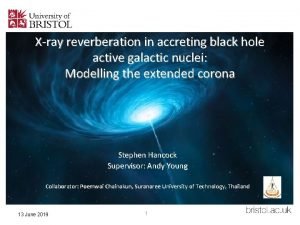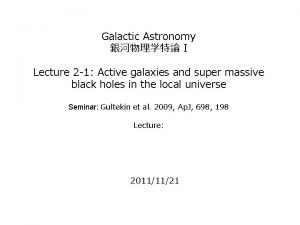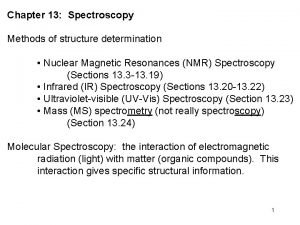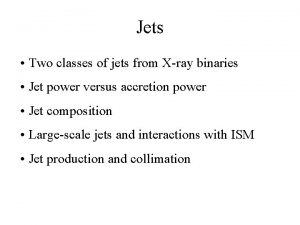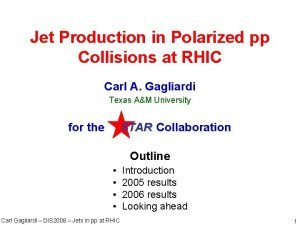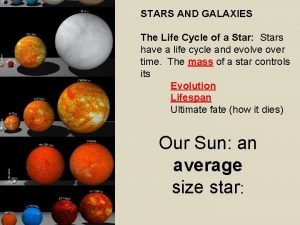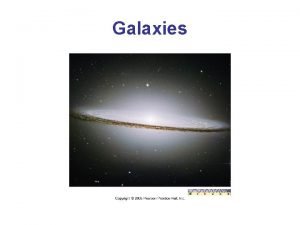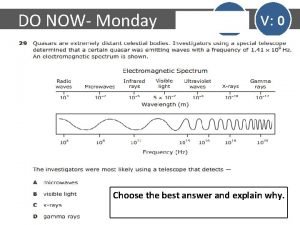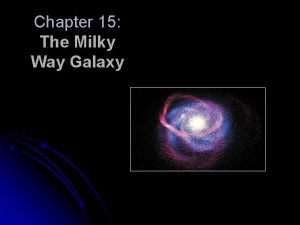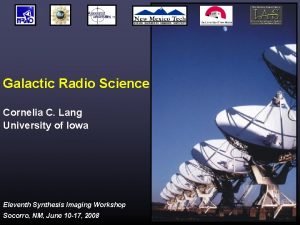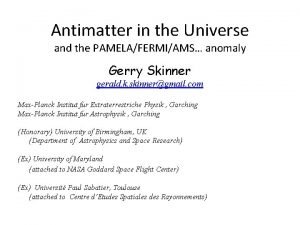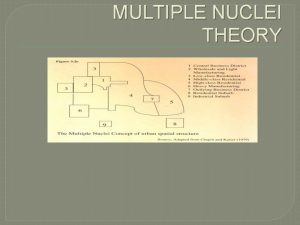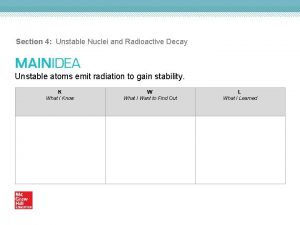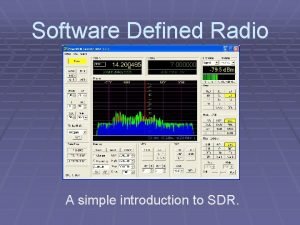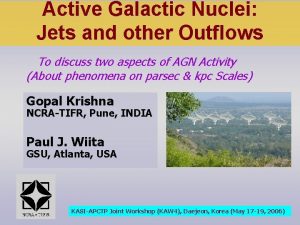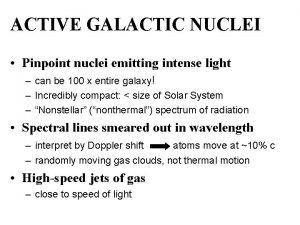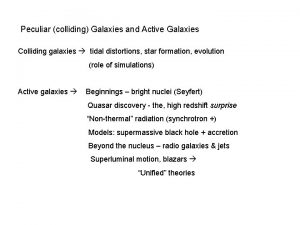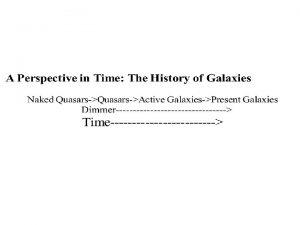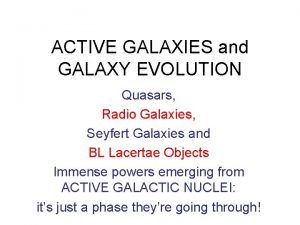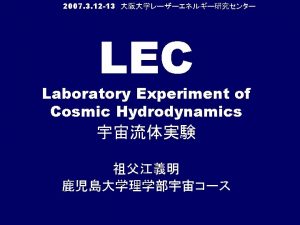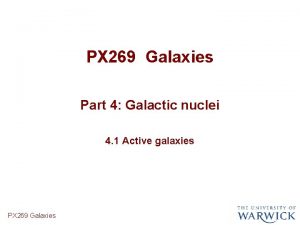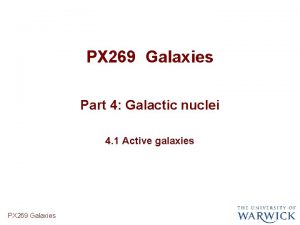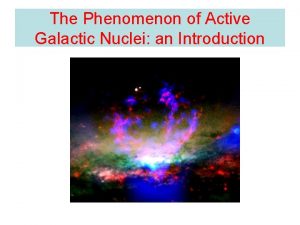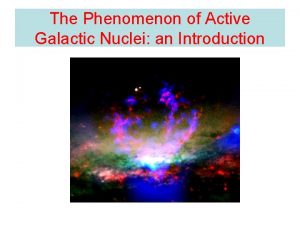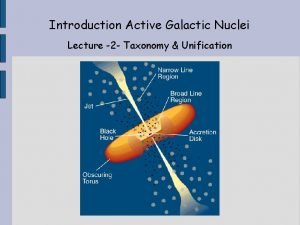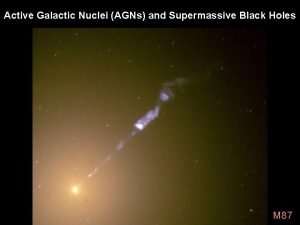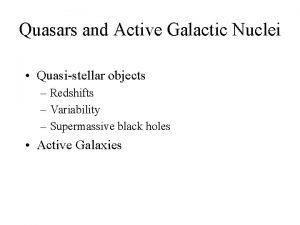Introduction Active Galactic Nuclei Jets Radio Galaxies and








































































- Slides: 72

Introduction Active Galactic Nuclei Jets

Radio Galaxies and radio-loud Quasars Radio galaxies & radio-loud quasars: the most powerful radio sources (Usually) extended (or very extended!) radio emission with common characteristics (core-jets-lobes) Typically hosted by an elliptical (early-type) galaxy Amazing discovery when they were identified with extragalactic, i. e. far away, objects Unexpectedly high amount of energy involved! The radio contribute only to a minor fraction of the energy actually released by these AGNs. (ratio between radio and optical luminosity ~10 -4) However, the kinetic power in jets can be a significant fraction of the accretion energy

Why study radio-loud AGN? They show most of the phenomena typical of AGNs (e. g. optical lines, X-ray emission etc. ) very interesting objects in (almost) all wavebands In addition they have spectacular radio morphologies But they are quite rare!

Some Radio surveys Start: 3 CR (Cambridge Telescope) 328 sources with > - 5 o flux above 9 Jy @ 178 MHz (1 Jy= 10 -26 W m-2 Hz-1) 4 C 2 Jy 178 MHz Cambridge (+5, 6, 7 C) PKS ~3 Jy 408 MHz Parkes Molonglo B 2 0. 25 408 MHz Bologna (+B 3) NRAO 0. 8 Jy 1. 4 -5 GHz NRAO PKS 0. 7 Jy 2. 7 GHz Parkes NVSS 2. 5 m. Jy (45” res. ) 1. 4 GHz NRAO VLA Sky Survey FIRST 1 m. Jy (~5” res) 1. 4 GHz Faint Images Radio Sky at Twenty centimeters 300 MHz WSRT WENSS

A prototypical radio galaxy Lobes Hot-spots Core Jets Any size: from pc to Mpc First order similar radio morphology (but differences depending on radio power, optical luminosity & orientation) Typical radio power 1023 to 1028 W/Hz

Radio Spectrum Note the scales on both axis! S steep: <-0. 5 flat: >-0. 5 inverted: >0 flat/inverted/peaked & variable spectrum Steep spectrum with breaks Carilli et al. (1999)

Radio-Dichotomy Only Steep-Spectrum Quasars! Ellipticals + Spirals Ellipticals R=radio/optical flux Kellermann et al. (1989) Falcke, Sherwood, Patnaik (1996) Optically bight quasars come in two flavors: radio-loud and radioquiet This is seen in a homogenous optically selected sample (e. g. PG/BQS quasar sample). Normalizing the radio emission (jet) by the optical luminosity (disk): only 10% of quasars are radio-loud. In both groups radio comes from jets! Why the difference in efficiency? It is not clear whether that persists also at lower masses and accretion rates…

Jet-Disk Symbiosis (looking at radio core only!) Jet power scales with accretion disk power Seyferts Model applicable to quasars LLAGN X-ray binaries Accretion disk luminosity Falcke et al. (1994 -2000) Radio Core Luminosity Qjet = qj/l · Ldisk Sradio L 17/12

Jets exist on all scales and also in “radio quiet” AGN: Seyfert Galaxies

Radio Structures in Seyferts

VLA Observations of RQQs (Radio Quiet Quasars) Leipski, C. ; Falcke, H. ; Bennert, N. ; Hüttemeister, S. (2006)

Jets exist on all scales X-ray binaries Low-Luminosity AGN Mirabel & Rodriguez (1994) VLBI: Falcke, Nagar, Wilson et al. (2000)

Jets • Not well understood • Emitted from axis of rotation • Acceleration through magnetic fields • Acceleration of charged particles from strong magnetic fields and radiation pressure • Synchrotron Radiation – Produces radiation at all wavelengths especially at Radio wavelengths • Possible source of Ultra high energy cosmic rays and neutrinos

Jets Often the radio emission is more symmetric on the large scale and asymmetric on the small scale The core is defined based on the spectral index: flat ( ~ 0) [to find which component is the radio core is not always easy: free-free absorption can complicate the story!] core

Jet in M 87 Discovery of AGN jet (Active Galactic Nucleus) in M 87 (Curtis 1918) “. . . curious straight ray. . . ” Is: optical synchrotron radiation from relativistic plasma jet ejected from black hole Hubble shows superluminal motion v~6 c HST: Biretta et al. (1999)

Black Hole powered jet in M 87 Reid et al. (1999, Space VLBI)

Jets Collimation Going very close to the BH to see how the collimation of the jet works. rapid broadening of the jet opening angle as the core is approached on scale below 1 mas (0. 1 pc). 43 GHz VLBI ~ 1 mas = 0. 071 pc M 87 The jet does not seem to reach a complete collimation until a distance of many tens of Schwarzschild radii (escape velocity = c) Jet emanating from the accretion disk, not yet collimated

Monitoring of the quasar 3 C 120 with VLBI

Superluminal motions Read old jet lecture on superluminal motion and beaming! These projection effects explain: the apparent superluminal motion the asymmetry between the two jets, also the flux of the approaching and receding components are affected by projection (Doppler Boosting) These are among the methods used to find out the orientation of a source

Jet to Counter Jet Ratios: boosting & de-boosting The jet to counter jet ratio of the inner jet can be modeled by a relativistic, decelerating jet with a fast spine and a slower shear layer (Laing & Bridle 2002). The observed jet/counter-jet brightness ratio (sidedness) at a resolution of 0. 75 arcsec, from the 8. 4 -GHz observations. This was constructed by dividing the image by a copy of itself rotated through 180 degree and is in the sense main jet/counter-jet.

3 C 31: Jet to Counter Jet Ratios

BL Lacs – looking down the jet Read old jet lecture on superluminal motion and beaming! Synchrotron from jet Reprocessed radiation from jet Z~100 Rg S Fossati et al. (1998) BL Lacs are thought to be beamed FRI radio galaxies ponting at us. Relativistic beaming will lead to an enhancement of the core emission by a huge factor (103) In BL Lacs the emission is completely dominated by the innermost jet. The spectrum is “flat” in S and rising linearly with in a S plot. There is no evidence for a disk spectrum (probably because FRIs have a radiatively inefficent disk/ADAF). The spectrum resembles a „camel‘s back“. Radio - optical: synchrotron emission from jet X-ray – Te. V: inverse Compton or hadronic cascades (e- , p- )

Jet Formation All relativistic cosmic jet sources may be connected by a common basic mechanism A promising model for that is magnetohydrodynamic acceleration by rotating, twisted magnetic fields Geometrically thick accretion flows are more efficient at launching jets In Microquasars this principle may explain the correlation between the production of a jet and the presence of a hot, geometrically thick accretion flow This also may be testable in some Seyfert AGN as well There is some evidence for this in AGN jets “Spin Paradigm” can explain qualitatively a number of statistical properties of AGN Slow acceleration and collimation of these jets is probably the norm Highly relativistic jet flows may be produced by strong, straight magnetic fields All galactic cosmic jet sources, including supernovae and gamma-ray bursts, may be connected by a common origin as well: different outcomes of the last stage of evolution in a massive star

Basic Principles of Magnetohydrodynamic Jet Production Basic MHD mechanism: Blandford (1976); Lovelace (1976) Acceleration by rotating black holes (Blandford & Znajek [1977]) Acceleration by rotating [thin] accretion disks (Blandford & Payne [1982]) • • First numerical simulations: Uchida & Shibata (1985) Key ingredients in their “Sweeping Pinch” mechanism – – Thick accretion disk or torus Keplerian differential rotation ( R-3/2) Initial strong vertical magnetic field (strong enough to slow disk rotation) J B force splits up into magnetic pressure and tension: - (B 2 / 8 ) + (B B) / 4

Basic Principles of Magnetohydrodynamic Jet Production (continued) Typical results (e. g. , Kudoh et al [1998]; Uchida et al. [1999]) Differential rotation twists up field into toroidal component, slowing rotation Disk accretes inward, further enhancing differential rotation and B Greatest field enhancement is at torus inner edge – – Kudoh, Matsumoto, & Shibata (2002) Magnetic pressure gradient (d. B 2 / d. Z) accelerates plasma out of system Magnetic tension [hoop stress] (–B 2/R) pinches and collimates the outflow into a jet Outflow jet speed is of order the escape velocity from the inner edge of the torus (Vjet ~ VAlfven ~ Vesc) Jet direction is along the rotation axis

Simulated jet evolution in the ISM

The basic jet emission model for the flat-spectrum core Blandford & Königl (1979), Falcke & Biermann (1995) Plasma freely expanding in a supersonic jet B r-1, n r-2, e ~ const superposition of selfabsorbed synchrotron spectra at each frequency one sees the = 1 surface as the “core” flat spectrum subject to rel. boosting Jets are messy - their radio cores are simple

The Spectrum of Jet-Cores: Free Expansion Approach Plasma propagates at a constant proper speed vz= j jc. The (isothermal) plasma expands with sound speed vr= s sc. The resulting shape is a cone with Mach number vr vz

The Spectrum of Jet-Cores: Particle and Energydensity Scaling Particle conservation: vr vz Energy conservation:

The Spectrum of Jet-Cores: Synchrotron Absorption: vr vz At a specific observing frequency we see the =1 surface; the location is frequency dependent: r =1 -1

The Spectrum of Jet-Cores: Synchrotron Emission: vr vz The emission is dominated by the =1 surface. For a conical jet the spectrum is flat!

Size and Spectrum of Sgr A* (Galactic Center) “submm-bump” 1000 Rg 100 Rg siz e shadow of event horizon The spectrum cuts off at the size scale of the event horizon! 10 g Size of Sgr A* cut-off 1 Rg Melia & Falcke (2001, Ann. Rev. Astron. &Astroph)

The Synchrotron Spectrum of Jets Rmin Mbh~108 Rmin max S S Radio/mm ~ -0. 7 S Radio/mm Opt/UV/X In jets r-1 max rmin-1 Mbh-1 Turnover Frequency in stellar black holes >> blazars!

Scaling of Jets: large, small, powerful and faint The basic shape of the broad -band jet spectrum is (relatively) invariant to changes in black hole mass and accretion rate. Simple scaling laws with Mdot can be derived analytically. Assumption Mdot Pjet! Radio/optical/X-ray ratio depends on Mbh and Mdot! Smaller black holes peak at higher frequencies. Increasing Mdot increases flux density non-linearly. Scaling laws for Blandford & Königl jet cores. bla ck ma hole ss Falcke & Biermann (1995) Markoff et al. (2003) Falcke et al. (2003) see also: Heinz & Sunyaev (2003) and Merloni et al. (2003)

Jet Model for the X-Ray Binary XTE J 1118+480 Markoff, Falcke, Fender (2001) .

The Power-Evolution of XRBs Radio & X-ray Spectrum Accretion Disk Radio Jet -disk Thermal disk spectrum Disk corona or jet spectrum? ADAF -disk ADAF Non-thermal jet spectrum -disk ADAF Fender (2000)

Spectrum of a Luminous Quasar thermal (disk) Synchrotron inverse Compton (jet) Lichti et al. (1994)

“JDAFs” Jet-Dominated Accretion Flows The SED has jet and disk contributions! At lower accretion rates disks become less and less prominent, jets remain strong. Sub-Eddington black hole SEDs may be jetdominated. Lx, r jet domination – disk domination Disk Jet low-state high-state (A/C)DAF + Jet ADAF: Esin, Narayan et al. (1997 …) Körding, Falcke, & Markoff (2002); see also Fender, Gallo, & Jonker (2003)

Scaling of Jets: large, small, powerful and faint Remember in the jet model: Scaling laws for Blandford & Königl jet cores. Radio/optical/X-ray ratio depends on Mbh and Mdot! Assuming that the scaling-laws are correct, radio, optical, mass, and accretion rate are connected: . E. g. one predicts that all jetdominated BHs lie on a plane in the parameter space given by mass, accretion rate, and X-ray emission This means: if one simply plots radio vs. X-ray emission of BHs the data will be scattered (since there is a range in mass and accretion rate), however, if one scales the X-ray emission to a common mass, there will be more order in the chaos… bla ck ma hole ss Falcke & Biermann (1995) Markoff et al. (2003) Falcke et al. (2003) see also: Heinz & Sunyaev (2003) and Merloni et al. (2003)

Fundamental Plane: Radio, X-Rays, and Mass Stellar mass BHs Mass corrected Supermassive BHs Corrected for mass Merloni, Heinz, Matteo (2003) Falcke, Körding, Markoff (2004)

jet-scaling Testing different scaling laws jet-disk scaling X-ray emission Scaled to common mass Restriction to Sub-Eddington BHs: XRBs, LLAGN, FRIs, BL Lacs Sample containing only Low-State AGNs FRIs & BL Lacs LLAGN (LINERS) XRBs =0. 4 dex Radio emission Falcke, Körding, Markoff (2004) Körding, Falcke, Corbel (2005)

Power Unification Black holes have no hair! Stellar and supermassive blacks have more and more in come … BH, Jet, disk, variability Main parameters: M , Mdot XRB state transitions seem to have their equivalent in AGN classes Sub-Eddington Black Holes may turn from disk- to jet-dominated. Spectrum dominated by jet Energy output dominated by (kinetic) jet power Fundamental plane of BH activity describes spectral evolution (best for sub-Eddington BHs) Radio quietness related to jetquenching in High-state or not? Falcke, Körding, Markoff (2004)

Feedback in radio-loud AGN? Feedback of radio-loud AGN into the surrounding IGM (seen through X-ray here). The kinetic impact of jets causes the X-ray gas to be displaced. The consequence are holes in the X-ray emission. Fabian et al.

M 87 is considered a low -luminosity AGN. Radio jet powers huge radio lobe and pushes out hot X-ray gas. Energy output from black hole dominates environment of galaxy. 260, 000 Light years Black Hole powered jet in M 87 s h g Li 0 0 0 r a e t y , 16 VLA 327 MHz: Owen et al. (1999)

Radio Loud AGN: FR I – FR II Weak or no emission lines, no blue bump Radio Power Strong emission lines, blue bumps seen

FR I/FR II division Owen-Ledlow diagram 1 = FR II 2 = FR I FRI and FRII radio galaxies delineated by sharp division in optical/ radio luminosity plane Bigger galaxies need more powerful radio galaxies for the jets to emerge unharmed by shear forces in the ISM. FR II FR I Owen & Ledlow (last century)

Shock waves in jets Lifetimes short compared to extent of jets => additional acceleration required. Most jet energy is ordered kinetic energy. Gas flow in jet is supersonic; near hot spot gas decelerates suddenly => shock wave forms. Energy now in relativistic e- and mag field.

Particle Acceleration in jets: shocks and more 3 C 273 M 87 jet spectra of bright knots Emission is typically in power law form Meisenheimer et al. (1997) Optical and perhaps X-ray synchrotron require Te. V electrons and continuous re-acceleration in the jet!

Radio Spectra: Age Effects 1. Energy loss 2. Self-absorption in the relativistic electrons gas 3. Absorption from ionized gas between us and the source (free-free absorption) -> torus! Theory Reality cooling absorption

Electron Energy Distribution in Jets d. Ne( e) d e S d. Ne( e) d e e-2 B e 2 • • 1 100 104 e 0. 5 The typical energy distribution of relativistic electrons is a power-law in e (E= emec 2). The energy of electrons is related to a characteristic frequency. A power-law in the energy distribution produces a powerlaw in the spectrum

Electron Energy Distribution in Jets S B e 2 • 1 100 e 4 10 0. 5 Coincidentally in the inner jet region the lowfrequency spectrum is self-absorbed. Hence, electrons with 1 e 100 remain invisble but they could make up 99% of the total electron content! d. Ne( e) d e -1 e-2 Ntot min

Energy loss The relativistic electrons can loose energy because of a number of process (adiabatic expansion of the source, synchrotron emission, inverse-Compton etc. ). the characteristics of the radio source and in particular the energy distribution N(E) (and therefore the spectrum of the emitted radiation) tend to modify with time. Adiabatic expansion: strong decrease in luminosity but the spectrum is unchanged Energy loss through radiation: After a time tb only the particle with E 0<E* still survive while those with E 0>E* have lost their energy. For ν < νbreak the spectral index remains constant (α = α 0) νbreak ~ B-3 tyr-2 For ν > νbreak Single burst α = (α 0 -1/2) Continuous injection

Energy loss These energy lost affect mainly the large scale structures (e. g. lobes). Typical spectral index of the lobes = 0. 7 Typically 20 -50 Myr for B=10μG, freq 8 -1 GHz Unless there is re-acceleration in some regions of the radio source!

Self-absorption in the relativistic electron gas Optically thick case: the internal absorption from the electrons needs to be considered the brightness temperature of the source is close to the kinetics temperature of the electrons. The opacity is larger at lower frequency -> plasma opaque at low frequencies and transparent at high Frequency corresponding to =1

Self-absorption in the relativistic electron gas Affects mainly the central compact region or very small radio sources Higher “turnover” frequency smaller size of the emitting region.

Gigahertz Peak Spectrum and Compact Steep Spectrum Sources GPS = Gigahertz Peak Spectrum – characterized by a peak in the radio spectrum at ~ 1 GHz CSS = Compact Steep Spectrum – have steep spectra at microwave frequencies but also have a peak in the spectrum in the 10 -100 MHz range

GPS & CSS Sources – young (and frustrated sources) GPS (GHz-Peaked-Spectrum) and CSS (Compact-Steep-Spectrum) sources are young radio jets that are still stuck in the dense ISM. GPS Turn-over frequency scales inversely with size Likely effect of selfabsorption. O’Dea 1998 CSS D=68 Mpc 5 pc/mas Size: ~250 pc

GPS at work: The “Seyfert” Galaxy III Zw 2 Flux increase by factor 20 -250 within years Outbursts roughly every 5 years Radio monitoring campaign set up in anticipation of current outburst Aller et al. , priv. com.

The Extreme Variability of the Seyfert Galaxy III Zw 2 Flux increase by factor 40 (!) within 2 years Outburst peaks at 7 mm Textbook-like selfabsorbed spectrum ( =2 -2. 5) Fitted by two synchrotron components. Millimeter-Peaked-Spectrum(MPS) l=7 mm Falcke, Bower, et al. (1999, Ap. JL)

III Zw 2 - Spectral Evolution cay Rise De The spectrum remained highly inverted, peaking at 43 GHz during the rise of the outburst. Peak frequency dropped quickly after peak in 43 GHz lightcurve (decay). Ri se Decay

III Zw 2 - Structural Evolution The source remained ultra-compact during the rise, but requiring at least two compo-nents separated by 72 mas (=0. 1 pc). No other components found! Structural expansion seen during the decay. Rise Decay

Evolution of III Zw 2 Simultaneous VLBI and VLA observations Very close correspondence between spectral and structural evolution! VLBI monitoring • superresolved (150 mas) • 5 epochs interpolated • VLA monitoring • Monthly sampling • 13 epochs interpolated • Brunthaler, Falcke, Bower et al. (2000)

Polarization Characteristic of the synchrotron emission: the radiation is highly polarized. For an uniform magnetic field, the polarization of an ensemble of electrons is linear, perpendicular to the magnetic field and the fractional polarization is given by: 0. 7 - 0. 8 for 2<p<4 never! Typical polarization from few to ~20% Tangled magnetic field

Polarization between 10 and 20% (some peaks at ~40% around the edge of the lobes)

Polarization Example of polarization in radio jets.

Faraday rotation Travel through a plasma+magnetic field (that can be internal or external to the source) changes the polarization angle Rotation measure (RM) Ne = electron density of the plasma dl = depth B = component of the magnetic field parallel to line of sight RM can be derived via observations at different wavelengths If the medium is in front of the radio source: no change in the fractional polarization If the medium is mix in the radio source: depolarization dependence on wavelength (if due to Faraday rotation) thermal electrons with density ~ 10 -5 cm-3 Depolarization happens also if the magnetic field is tangled on the scale of the beam of the observations

Different types of radio galaxies The morphology of a radio galaxy may depend on different parameters: - radio power (related to the power of the AGN? ) - orientation of the radio emission - intrinsic differences in the (nuclear regions of) host galaxy - environment

Different types of radio galaxies

Different types of radio galaxies ~200 kpc The morphology does not depend on size! ~20 pc

Effects of the interaction with the environment Effects of age

Restarting Jets V. L. Safouris, G. V. Bicknell, R. S. Sunrahmanyan & L. Saripalli, 2006, Ap. J

Summary Jets are ubiquitous and are seen in almost all types of sources at all black hole masses and all accretion rates. They are hot, collimated plasma streams close to the speed of light, beaming plays a role They are launched close to the black hole. They can carry a few percent of the total accretion power in the form of kinetic energy. Emission ranges over the entire e. m. spectrum – main processes are synchrotron and inverse Compton emission.
 Active galactic nuclei
Active galactic nuclei Active galactic nuclei
Active galactic nuclei Active galactic nuclei
Active galactic nuclei Galactic centre radio transients
Galactic centre radio transients How are galaxies classified? *
How are galaxies classified? * Nmr active and inactive nuclei
Nmr active and inactive nuclei Black hole jets
Black hole jets Jets
Jets Jets
Jets Jets
Jets Parton distribution functions
Parton distribution functions Jets
Jets Spice jets
Spice jets Spice jets
Spice jets Waves are produced by stars and galaxies
Waves are produced by stars and galaxies Chapter 30 galaxies and the universe
Chapter 30 galaxies and the universe Elliptical spiral and irregular
Elliptical spiral and irregular Life cycle of a galaxy
Life cycle of a galaxy Facts about elliptical galaxies
Facts about elliptical galaxies Th eirregulars
Th eirregulars The pity relation for an adiabatic expansion is
The pity relation for an adiabatic expansion is Milky way galaxy shape
Milky way galaxy shape What are galaxies
What are galaxies Brainpop galaxies quiz answers
Brainpop galaxies quiz answers 4 types of galaxies
4 types of galaxies Tipus de galaxies
Tipus de galaxies Type of galaxy
Type of galaxy Evolution of galaxies
Evolution of galaxies Universepg
Universepg Galaxies lesson plan
Galaxies lesson plan Trunking vs conventional radio system
Trunking vs conventional radio system Galactic address
Galactic address African city model
African city model Combine vs galactic empire
Combine vs galactic empire Sector model
Sector model Harris peripheral model
Harris peripheral model Galactic habitable zone
Galactic habitable zone Galactic phonics ure
Galactic phonics ure Galactic cap review
Galactic cap review Martina cardillo
Martina cardillo Galactic habitable zone
Galactic habitable zone Galactic
Galactic Boolean operators
Boolean operators Active transport
Active transport Radio active decay
Radio active decay Primary active transport vs secondary active transport
Primary active transport vs secondary active transport Bid rent theory example
Bid rent theory example Multiple nuclei model cons
Multiple nuclei model cons Multiple nuclei model criticisms
Multiple nuclei model criticisms Homer hoyt sector model
Homer hoyt sector model Difference between sector model and multiple nuclei model
Difference between sector model and multiple nuclei model Urban realms model
Urban realms model Unstable nuclei and radioactive decay
Unstable nuclei and radioactive decay Introduction to software defined radio
Introduction to software defined radio Active directory introduction
Active directory introduction Introduction to active directory
Introduction to active directory Squatter settlements ap human geography
Squatter settlements ap human geography Bidrent theory
Bidrent theory Trunchiul cerebral fata anterioara
Trunchiul cerebral fata anterioara Sector model ap human geography
Sector model ap human geography Harris ullman multiple nuclei model
Harris ullman multiple nuclei model Where is the limbic system located
Where is the limbic system located Reticular formation
Reticular formation Cerebriform nuclei
Cerebriform nuclei Commuter zone concentric zone model
Commuter zone concentric zone model Criticism of concentric zone theory
Criticism of concentric zone theory Periventricular nucleus vs paraventricular
Periventricular nucleus vs paraventricular Cerebral peduncle
Cerebral peduncle Neo malthusians definition ap human geography
Neo malthusians definition ap human geography Extrapyramidal tract
Extrapyramidal tract Orphan annie eye nuclei
Orphan annie eye nuclei Diencephalon
Diencephalon Comment démarrer un nuclei
Comment démarrer un nuclei
